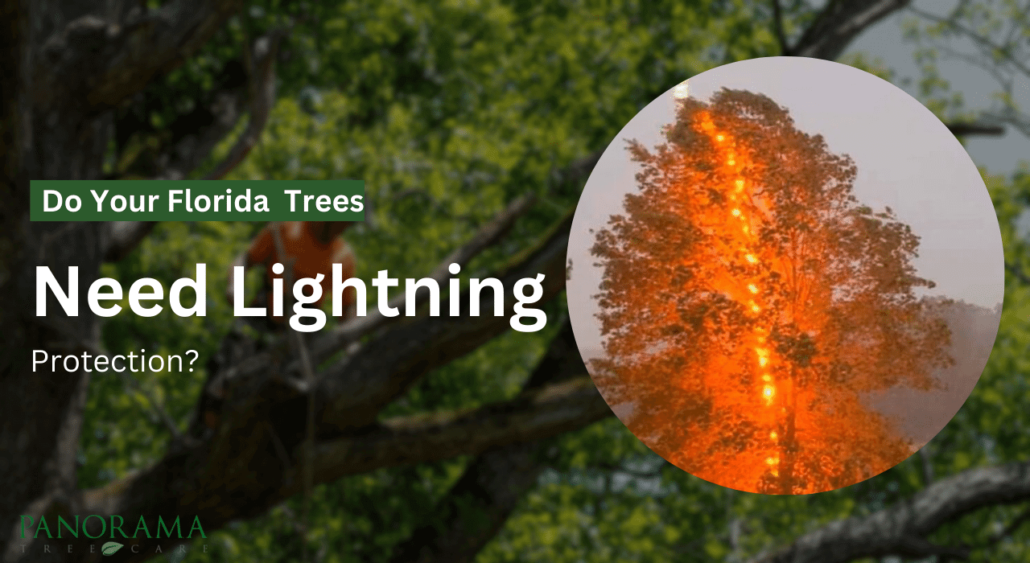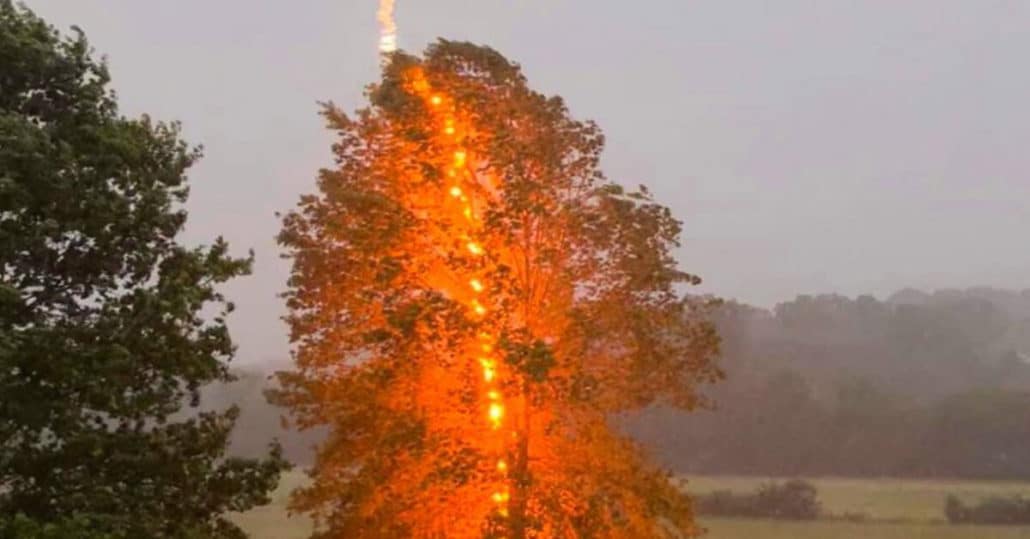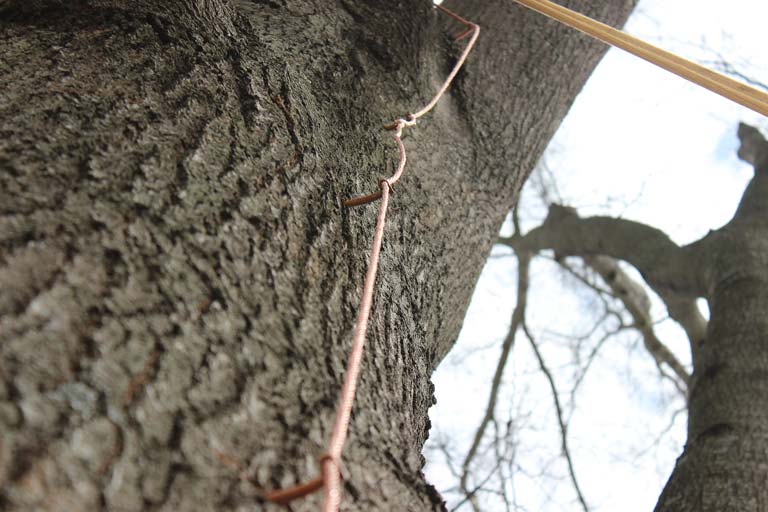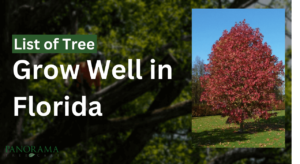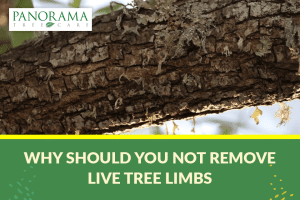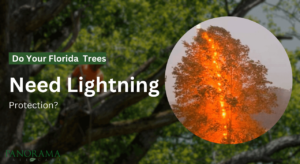The lush, towering trees that grace Florida landscapes are often prized possessions, adding beauty, shade, and value to properties across the state.
However, these majestic plants face a unique threat – lightning strikes.
Florida’s frequent thunderstorms and high annual lightning rate put trees at risk of severe damage or even death from these powerful electrical events.
That’s where lightning protection systems come in, providing a crucial defense for your treasured trees.
Signs Your Florida Trees Need Lightning Protection
Several factors can indicate that your trees may benefit from a professional lightning protection system installed by Panorama Tree Care:
- Tall or isolated trees that stand out from their surroundings are more likely to be struck.
- Trees that have already sustained lightning damage in the past are at higher risk for future strikes.
- Trees located near structures, power lines, or areas with high foot traffic pose safety hazards if struck.
- Valuable, historic, or irreplaceable trees warrant extra protection due to their significance.
How Lightning Protection Systems Work
Lightning protection systems for trees are ingeniously designed to safeguard trees against the devastating impacts of lightning strikes.
Components of a Lightning Protection System
Air Terminals (Lightning Rods)
Air terminals, commonly referred to as lightning rods, are critical components of a lightning protection system.
Installed at the highest points of a tree, these rods are designed to intercept lightning strikes.
Made from conductive materials like copper or aluminum, air terminals catch the lightning strike, providing a safe pathway for the lightning to travel down to the ground, thereby protecting the tree from the direct impact of the lightning.
Conductors
Conductors are heavy-duty cables that connect the air terminals to the ground rods. These conductors are crucial for the safe transmission of electrical energy from the lightning strike down to the earth.
They are typically made of highly conductive materials such as copper or aluminum to ensure minimal resistance and efficient flow of the electrical current.
The conductors are securely attached to the tree, often running along its trunk and branches, to provide a direct path for the lightning to follow.
Ground Rods
Ground rods are the final component of the system, buried deep into the earth. Their purpose is to safely disperse the electrical charge from the lightning into the ground, preventing it from damaging the tree.
These rods are usually made of copper or galvanized steel and must be installed deep enough to reach moist soil to ensure effective grounding.
The depth and number of ground rods required can vary based on the soil conditions and the size of the tree being protected.
Process of Dissipating Lightning Energy Safely into the Ground
When lightning strikes a tree equipped with a protection system, the electrical charge is intercepted by the air terminals.
From there, the charge is conducted down through the cables to the ground rods. This process provides a low-resistance path, essentially guiding the lightning safely into the ground without allowing it to pass through the tree itself.
By doing so, the system prevents the enormous electrical energy from traveling through the tree’s tissues, which could cause explosive steam pressure, splintering the wood and severely damaging the tree’s vascular system.
Benefits of Properly Installed Systems
The primary benefit of a properly installed lightning protection system is the preservation of the tree’s life and health.
Trees that might otherwise be severely damaged or killed by a lightning strike can continue to grow and thrive, thanks to these systems.
Furthermore, by protecting trees, these systems also safeguard the surrounding property and individuals.
A damaged tree can pose significant risks, from falling branches to increased susceptibility to disease and decay, which can affect nearby structures and people.
Properly installed and maintained lightning protection systems mitigate these risks, contributing to the safety and aesthetic value of the landscape.
Consequences of Unprotected Lightning Strikes
When lightning strikes a tree that doesn’t have any form of protection, the consequences can be severe, not just for the tree itself but also for its surroundings.
Potential for Tree Damage or Death
Lightning carries an immense amount of energy. When it strikes an unprotected tree, the water inside the tree’s cells can rapidly boil, turning into steam.
Since steam occupies more space than water, this sudden expansion can cause the tree to explode or split apart.
Even if the tree doesn’t immediately break, the electrical charge can severely damage the tree’s vascular system.
This system is responsible for transporting water and nutrients from the roots to the leaves. Damage to this system can starve the tree of nutrients, leading to a slow death.
Safety Hazards from Falling Branches or Debris
A tree that has been struck by lightning and has suffered structural damage poses a significant risk to its surroundings.
Weak and damaged branches can fall at any time, posing dangers to anyone passing under the tree.
This is particularly hazardous in areas where people frequently walk or gather, such as parks, sidewalks, and residential areas.
Additionally, the debris from such damage can block roads, damage vehicles, and cause accidents, leading to further safety concerns.
Property Damage Risks from Fires or Explosions
The risk extends beyond the tree itself. Lightning can ignite fires, especially in dry conditions.
If a tree near a home or other structure is struck and catches fire, the flames can easily spread, leading to property damage and potentially catastrophic losses.
Moreover, in rare cases, lightning striking a tree can cause explosions if it hits a pocket of decay within the tree, which may contain gases from decomposing material.
Such explosions can send debris flying, causing damage to nearby property and endangering lives.
Cost Considerations
The financial aspects of installing lightning protection systems for trees are an important consideration for property owners. Let’s break down the cost considerations in detail.
Upfront Installation Costs
The initial investment in a lightning protection system involves several components, including air terminals (lightning rods), conductors (cables), and ground rods, along with the labor costs for professional installation.
The price can vary widely based on the size and number of trees being protected, the complexity of the installation, and the specific materials used.
While this upfront cost might seem substantial, it’s important to view it in the context of an investment in the longevity and health of your trees, as well as the safety of your property and its occupants.
Long-term Benefits of Protecting Valuable Trees
Investing in lightning protection offers significant long-term benefits. Firstly, it helps preserve the aesthetic and environmental value of mature trees, which can take decades to replace.
Trees contribute to property value, enhance air quality, and provide shade and habitat for wildlife. Moreover, healthy, mature trees can significantly increase property values.
The cost of a lightning protection system often pales in comparison to the combined value of these benefits over time.
Additionally, by protecting trees from lightning damage, you’re also safeguarding the surrounding area.
Trees struck by lightning can become hazardous, potentially falling on buildings, vehicles, or people, leading to injury or costly damages. The protection system minimizes these risks, contributing to a safer environment.
Potential Savings from Avoiding Costly Tree Removals or Repairs
The costs associated with removing a large, damaged tree can be significant.
This includes not only the removal itself but also stump grinding and potential landscaping to repair the damage caused by the removal process.
If a lightning strike leads to property damage, the repair costs can quickly escalate, especially if structures are involved.
By investing in lightning protection, you can avoid these potential expenses. The system acts as insurance, mitigating the risk of incurring much higher costs in the event of a lightning strike.
FAQs
Do lightning protection systems work for all trees?
Systems are most effective for taller, more conductive tree species, but can provide benefits for many types of trees. A professional assessment is recommended.
Is installation difficult or damaging?
When performed by experienced professionals like Panorama Tree Care’s certified arborists, installation is done carefully to avoid harming the tree.
How long do these systems last?
With proper maintenance, lightning protection systems can remain effective for 30+ years, providing lasting value.
Call Panorama Tree Care Today
Don’t let the next lightning strike put your prized Florida trees at risk. Contact the experts at Panorama Tree Care for a professional assessment and learn how our lightning protection systems can provide years of peace of mind. Invest in preserving these iconic natural assets that enhance your property’s beauty, value, and safety.

